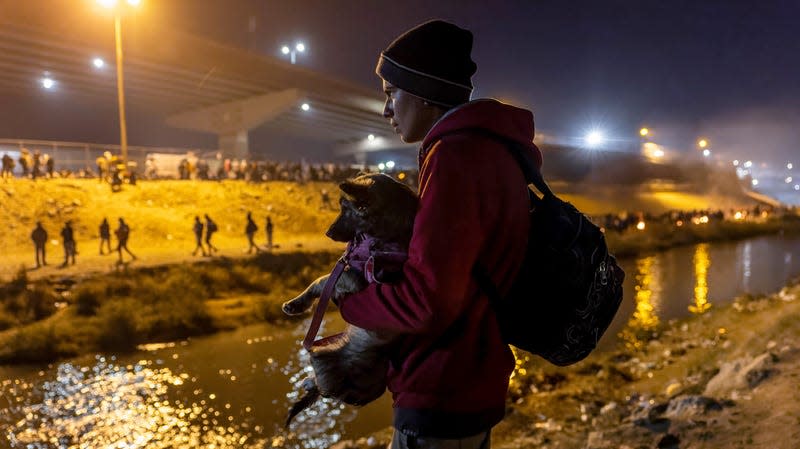The case for keeping Title 42 misses key pieces of the immigration puzzle

The pandemic-era public health rule allowing the US to turn away migrants from its borders without giving them a chance to seek asylum was on its way out—until the apex court stepped in.
Supreme Court chief justice John Roberts yesterday (Dec. 19) temporarily halted the end of Title 42 policy after a coalition of Republican-led states asked for intervention (pdf). The cohort’s request had been rejected by an appeallate court last Friday (Dec. 16).
Read more
The provision, which has been widely criticized by public health experts and human rights advocates, was meant to lift tomorrow (Dec. 21). Now, it will stay in place until the court considers the states’ request, which could take months.
Title 42 is staying, says the Department of Homeland Security (DHS)
“While this stage of the litigation proceeds, we will continue our preparations to manage the border in a safe, orderly, and humane way when the Title 42 public health order lifts.” —DHS’s response to the Supreme Court order
Title 42 during and after covid-19
Invoked by former president Donald Trump in March 2020, Title 42 allows authorities to expel individuals who come from countries where a disease has spread. Migrants have been turned away over 2.5 million times under the policy.
Public health officials cast doubt on its efficacy from the start. With covid vaccines and treatments largely available, the Centers for Disease Control and Prevention (CDC) declared Title 42 redundant in April. Pro-immigration advocates also argued it denied migrants the human right to asylum.
Republicans want Title 42 to stay to “prevent illegal immigration”
This isn’t the first time Republican-led states have sought to block the scrapping of Title 42. A federal judge in Louisiana blocked the Biden administration’s plans to lift the policy in May after several Republican-backed states pushed back on its revocation.
They argued that doing away with Title 42 would exacerbate the “crisis at our southern border,” which is already witnessing an unprecedented “scope and scale of illegal border crossings.” Several Republican leaders, including Texas governor Greg Abbott, have argued that keeping Title 42 in place “helps prevent illegal immigration.”
After years of border closures and a worsening of the economic situation in several Central and South American countries, a surge in migration is to be expected, but immigration rights advocates argue that Title 42 caused the bottleneck to begin with.
Thousands of people have lined up along the borders in anticipation of their opportunity to claim asylum. Near the southern border, where most migrant crossing into the US happens, two cities—El Paso, Texas, and Ciudad Juarez in Mexico—counted over 5,000 new arrivals a day in the run-up to Title 42 ending.
On Saturday (Dec. 17), El Paso Mayor Oscar Leeser issued a state of emergency as shelters filled up and pressure built on other resources. Humanitarian organization Red Cross arranged for additional shelter for 10,000 people in the Texan city through January.
Charted: El Paso’s migrant influx
Is Title 42 an effective immigration policy?
While the burden on federal authorities will mount whenever Title 42 expires, border security sought to reassure the public that it would keep enforcing existing policies to control the flow of migration. In its statement last week, the DHS clarified it had checks and balances in place to prevent unlawful crossings.
Reverting to expulsions under the federal statute, Title 8, may entail lengthier processes but they’d come with more stringent penalties, including up to two years in prison if a person re-enters the country illegally after being removed or deported.
Without those consequences, Title 42 offered “a means to get multiple opportunities to enter the United States,” Ariel Ruiz Soto, a policy analyst at the Migration Policy Institute think tank, told NBC News. “That is counterproductive because it in some ways incentivizes migrants to try multiple times and the more times that migrants try, the more likely that they’re successful,” he added.
Smugglers told Reuters their business boomed as they saved around $1,300 for every migrants who was returned at the US border rather than sent back to their homeland. They avoided having to pay off organized crime in Mexico once again, and could reattempt another crossing sooner.
Under Title 42, the recidivism rate—percentage of people apprehended more than once by a Border Patrol officer—increased from 7% in 2019 to as much as 27% in 2022.
The Trump-era “Remain in Mexico” policy is also subject to court battles
Last week, a federal judge stopped the Biden administration from terminating the “Remain in Mexico” policy. Officially called the Migrant Protection Protocols (MPP), the Trump-era policy lets the US government return certain asylum seekers to Mexico to wait through the duration of their cases pending in the US immigration court system. It was touted a way to keep illegal immigration at way, but it puts a vulnerable population at risk of “kidnappings, rapes, and other violent attacks,” nonpartisan activist organization Human Rights First argues.
Related stories
🚶 Most undocumented immigrants don’t cross the border illegally
🌎 In a hotter, more crowded world, immigration is inevitable
More from Quartz
Sign up for Quartz's Newsletter. For the latest news, Facebook, Twitter and Instagram.


